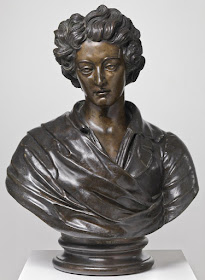 |
| Francis Legatt Chantrey Bust of Mr Warp 1816 marble Tate Gallery |
 |
| John Gibson Bust of William Bewick 1827-53 marble Tate Gallery |
 |
| Thomas Woolner Turner's Death Mask 1851 plaster Tate Gallery |
"One way to honour greatness during the nineteenth century was to take a plaster cast of the face after death. J.M.W. Turner's mask is attributed to the Pre-Raphaelite sculptor Thomas Woolner, a great admirer and collector of the older artist's works. Woolner often used death masks as the basis for portrait busts of his subjects, and he probably intended to create a posthumous tribute to Turner. He did the same for a number of other Victorian luminaries, including Charles Dickens."
 |
| Frederic Leighton Sketch for An Athlete wrestling with a Python ca. 1877 plaster Tate Gallery |
 |
| Hamo Thornycroft Sketch for Artemis 1880 plaster and wax Tate Gallery |
 |
| Amelia Robertson Hill Percy Bysshe Shelley 1882 bronze Tate Gallery |
"Hill came from the artistic Paton family and was herself a prominent Scottish sculptor, contributing three figures to the Scott Monument in Edinburgh. There is no reliable likeness of Percy Bysshe Shelley as an adult, and Hill's fascination for the Romantic poet translated into this monumental idealised bust. A prized possession, it was prominently displayed in the large vestibule of her studio until she died."
 |
| Edgar Degas Horse clearing an Obstacle ca. 1887-88 bronze Tate Gallery |
"Unlike many of his fellow Impressionists, Degas did not depict the pastoral delights of outdoor leisure pursuits, such as boating or picnics, nor did he practise landscape painting as an end in itself. He chose instead to concentrate on making down-to-earth paintings of laundresses, ballet dancers and women at their toilet. He also executed a number of works on the themes of horses and horse-racing. From about 1880 when his eyesight began to fail, Degas turned to making sculptures on a relatively small scale. This particular work, together with a number of other bronzes of horses, is thought to have been inspired by the photographs of Eadweard Muybridge showing horses in motion."
 |
| Alfred Gilbert Model for Eros on the Shaftesbury Memorial, Piccadilly Circus 1891 bronze Tate Gallery |
"This is the model for the well-known statue which stands in the centre of Piccadilly Circus. It crowns the memorial fountain to the great Victorian philanthropist, Lord Shaftesbury. The sculptor wrote of 'the blindfolded Love sending forth indiscriminately, yet with purpose, his missile of kindness, always with the swiftness the bird has from its wings.' The monument was unveiled in 1893 and was the first London statue to be cast in aluminum."
 |
| Frederick William Pomeroy The Nymph of Loch Awe 1897 marble Tate Gallery |
"The subject was based on an old legend explaining the origin of Loch Awe in the Scottish Highlands. A nymph was asked to watch a magic well to check that the water did not rise above a certain height. She fell asleep, the water rose and she drowned. Dead or dying female figures lying prostrate on the ground were a popular subject in French art at this time."
 |
| Thomas Brock Eve 1900 marble Tate Gallery |
"Brock exhibited this life-size female nude as a plaster cast at the Royal Academy in 1898. He completed the marble in the following year and showed it at the Paris Universal Exhibition. Critics praised its combination of naturalism and spiritualism, as well as its subtlety in modelling and expression of feeling. Unusually, Eve is not presented as a sensual temptress."
 |
| James Havard Thomas Castagnettes No. 2 1900 bronze Tate Gallery |
 |
| Auguste Rodin Woman on a Column ca. 1900-1903 copper electrotype Tate Gallery |
"This female figure is adapted from one entitled The Sphinx, from Rodin's monumental bronze doors known as The Gates of Hell. Rodin displayed a number of fragments of works in his studio on top of classical columns, and such an arrangement may have inspired this piece. Despite its rather delicate proportions, the impression here is of a full-size figure taken to an architectural scale."
 |
| Bertram Mackennal Diana Wounded ca. 1907 marble Tate Gallery |
"The Australian sculptor Mackennal came to London aged nineteen to study at the Royal Academy Schools, and went from there to work briefly under Rodin in Paris. He made sculpture for war memorials and public buildings in London and Australia. He was knighted in 1921 after designing the tomb of Edward VII. Diana was the moon goddess and wears the crescent moon in her hair. She also hunted, hence Diana Wounded ties a bandage to her leg. This action justified Mackennal in the display of a complicated pose. Edwardian architects worked well with sculptors such as Mackennal, whose confident and Baroque style matched their buildings. Skill in making convincing and varied figures was essential for architectural work in this era."
 |
| Pablo Picasso Head of a Woman (Fernande) 1909 plaster Tate Gallery (on long term loan from a private collection) |
"My greatest artistic emotions were aroused when the sublime beauty of the sculpture created by anonymous artists in Africa was suddenly revealed to me,' Picasso told the poet Apollinaire. This sculpture is of his companion Fernande Olivier. Its flat, planed surface relates the work to his cubist paintings of the same period. Picasso made two plaster casts of the head, from which at least sixteen bronze examples were cast."
– quoted passages based on notes by curators at the Tate in London